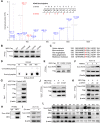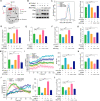SIRT5-mediated ME2 desuccinylation promotes cancer growth by enhancing mitochondrial respiration
- PMID: 38007551
- PMCID: PMC10781994
- DOI: 10.1038/s41418-023-01240-y
SIRT5-mediated ME2 desuccinylation promotes cancer growth by enhancing mitochondrial respiration
Abstract
Mitochondrial malic enzyme 2 (ME2), which catalyzes the conversion of malate to pyruvate, is frequently upregulated during tumorigenesis and is a potential target for cancer therapy. However, the regulatory mechanism underlying ME2 activity is largely unknown. In this study, we demonstrate that ME2 is highly expressed in human colorectal cancer (CRC) tissues, and that ME2 knockdown inhibits the proliferation of CRC cells. Furthermore, we reveal that ME2 is succinylated and identify Sirtuins 5 (SIRT5) as an ME2 desuccinylase. Glutamine deprivation directly enhances the interaction of SIRT5 with ME2 and thus promotes SIRT5-mediated desuccinylation of ME2 at lysine 346, activating ME2 enzymatic activity. Activated ME2 significantly enhances mitochondrial respiration, thereby counteracting the effects of glutamine deprivation and supporting cell proliferation and tumorigenesis. Additionally, the levels of succinylated ME2 at K346 and SIRT5 in CRC tissues, which are negatively correlated, are associated with patient prognosis. These observations suggest that SIRT5-catalyzed ME2 desuccinylation is a key signaling event through which cancer cells maintain mitochondrial respiration and promote CRC progression under glutamine deficiency conditions, offering the possibility of targeting SIRT5-mediated ME2 desuccinylation for CRC treatment.
© 2023. The Author(s), under exclusive licence to ADMC Associazione Differenziamento e Morte Cellulare.
Conflict of interest statement
The authors declare no competing interests.
Figures







Similar articles
-
Sirtuin5 contributes to colorectal carcinogenesis by enhancing glutaminolysis in a deglutarylation-dependent manner.Nat Commun. 2018 Feb 7;9(1):545. doi: 10.1038/s41467-018-02951-4. Nat Commun. 2018. PMID: 29416026 Free PMC article.
-
Desuccinylation of inosine-5'-monophosphate dehydrogenase 1 by SIRT5 promotes tumor cell proliferation.J Biol Chem. 2024 Dec;300(12):107976. doi: 10.1016/j.jbc.2024.107976. Epub 2024 Nov 8. J Biol Chem. 2024. PMID: 39522945 Free PMC article.
-
SIRT5-mediated deacetylation of LDHB promotes autophagy and tumorigenesis in colorectal cancer.Mol Oncol. 2019 Feb;13(2):358-375. doi: 10.1002/1878-0261.12408. Epub 2018 Dec 3. Mol Oncol. 2019. PMID: 30443978 Free PMC article.
-
Emerging roles of mitochondrial sirtuin SIRT5 in succinylation modification and cancer development.Front Immunol. 2025 Jan 29;16:1531246. doi: 10.3389/fimmu.2025.1531246. eCollection 2025. Front Immunol. 2025. PMID: 39944690 Free PMC article. Review.
-
SIRT5: a potential target for discovering bioactive natural products.J Nat Med. 2025 May;79(3):441-464. doi: 10.1007/s11418-024-01871-6. Epub 2025 Feb 20. J Nat Med. 2025. PMID: 39979670 Free PMC article. Review.
Cited by
-
SIRT5-Mediated Desuccinylation of RAB7A Protects Against Cadmium-Induced Alzheimer's Disease-Like Pathology by Restoring Autophagic Flux.Adv Sci (Weinh). 2024 Aug;11(30):e2402030. doi: 10.1002/advs.202402030. Epub 2024 Jun 5. Adv Sci (Weinh). 2024. PMID: 38837686 Free PMC article.
-
P5CS deacetylation mediated by SIRT2 facilitates tumor growth by enhancing mitochondrial respiration in hepatocellular carcinoma.Oncogene. 2025 Aug;44(31):2746-2761. doi: 10.1038/s41388-025-03456-3. Epub 2025 May 27. Oncogene. 2025. PMID: 40425834
-
Mitochondrial metabolism and cancer therapeutic innovation.Signal Transduct Target Ther. 2025 Aug 4;10(1):245. doi: 10.1038/s41392-025-02311-x. Signal Transduct Target Ther. 2025. PMID: 40754534 Free PMC article. Review.
-
GCLC desuccinylation regulated by oxidative stress protects human cancer cells from ferroptosis.Cell Death Differ. 2025 Apr 5. doi: 10.1038/s41418-025-01505-8. Online ahead of print. Cell Death Differ. 2025. PMID: 40188196
-
BACH1 deficiency improves placental angiogenesis via SLC25A51-mediated mitochondrial NAD+ transport in intrahepatic cholestasis of pregnancy.Mol Med. 2025 May 1;31(1):162. doi: 10.1186/s10020-025-01215-4. Mol Med. 2025. PMID: 40312332 Free PMC article.
References
Publication types
MeSH terms
Substances
Grants and funding
LinkOut - more resources
Full Text Sources
Molecular Biology Databases

